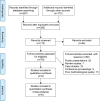Effect of rhythmic auditory cueing on gait in cerebral palsy: a systematic review and meta-analysis
- PMID: 29339922
- PMCID: PMC5746070
- DOI: 10.2147/NDT.S148053
Effect of rhythmic auditory cueing on gait in cerebral palsy: a systematic review and meta-analysis
Abstract
Auditory entrainment can influence gait performance in movement disorders. The entrainment can incite neurophysiological and musculoskeletal changes to enhance motor execution. However, a consensus as to its effects based on gait in people with cerebral palsy is still warranted. A systematic review and meta-analysis were carried out to analyze the effects of rhythmic auditory cueing on spatiotemporal and kinematic parameters of gait in people with cerebral palsy. Systematic identification of published literature was performed adhering to Preferred Reporting Items for Systematic Reviews and Meta-Analyses and American Academy for Cerebral Palsy and Developmental Medicine guidelines, from inception until July 2017, on online databases: Web of Science, PEDro, EBSCO, Medline, Cochrane, Embase and ProQuest. Kinematic and spatiotemporal gait parameters were evaluated in a meta-analysis across studies. Of 547 records, nine studies involving 227 participants (108 children/119 adults) met our inclusion criteria. The qualitative review suggested beneficial effects of rhythmic auditory cueing on gait performance among all included studies. The meta-analysis revealed beneficial effects of rhythmic auditory cueing on gait dynamic index (Hedge's g=0.9), gait velocity (1.1), cadence (0.3), and stride length (0.5). This review for the first time suggests a converging evidence toward application of rhythmic auditory cueing to enhance gait performance and stability in people with cerebral palsy. This article details underlying neurophysiological mechanisms and use of cueing as an efficient home-based intervention. It bridges gaps in the literature, and suggests translational approaches on how rhythmic auditory cueing can be incorporated in rehabilitation approaches to enhance gait performance in people with cerebral palsy.
Keywords: ataxia; balance; entrainment; hemiplegia; rehabilitation; spastic diplegia.
Conflict of interest statement
Disclosure The authors report no conflicts of interest in this work.
Figures






Similar articles
-
Effects of Rhythmic Auditory Cueing in Gait Rehabilitation for Multiple Sclerosis: A Mini Systematic Review and Meta-Analysis.Front Neurol. 2018 Jun 11;9:386. doi: 10.3389/fneur.2018.00386. eCollection 2018. Front Neurol. 2018. PMID: 29942278 Free PMC article.
-
Virtual Reality Enhances Gait in Cerebral Palsy: A Training Dose-Response Meta-Analysis.Front Neurol. 2019 Mar 26;10:236. doi: 10.3389/fneur.2019.00236. eCollection 2019. Front Neurol. 2019. PMID: 30984095 Free PMC article. Review.
-
Effect of Rhythmic Auditory Cueing on Aging Gait: A Systematic Review and Meta-Analysis.Aging Dis. 2018 Oct 1;9(5):901-923. doi: 10.14336/AD.2017.1031. eCollection 2018 Oct. Aging Dis. 2018. PMID: 30271666 Free PMC article. Review.
-
Effect of rhythmic auditory cueing on parkinsonian gait: A systematic review and meta-analysis.Sci Rep. 2018 Jan 11;8(1):506. doi: 10.1038/s41598-017-16232-5. Sci Rep. 2018. PMID: 29323122 Free PMC article.
-
Effects of (music-based) rhythmic auditory cueing training on gait and posture post-stroke: A systematic review & dose-response meta-analysis.Sci Rep. 2019 Feb 18;9(1):2183. doi: 10.1038/s41598-019-38723-3. Sci Rep. 2019. PMID: 30778101 Free PMC article.
Cited by
-
Prevalence of Vestibular Dysfunction in Children With Neurological Disabilities: A Systematic Review.Front Neurol. 2019 Dec 17;10:1294. doi: 10.3389/fneur.2019.01294. eCollection 2019. Front Neurol. 2019. PMID: 31920918 Free PMC article.
-
Effects of Rhythmic Auditory Cueing in Gait Rehabilitation for Multiple Sclerosis: A Mini Systematic Review and Meta-Analysis.Front Neurol. 2018 Jun 11;9:386. doi: 10.3389/fneur.2018.00386. eCollection 2018. Front Neurol. 2018. PMID: 29942278 Free PMC article.
-
Auditory Stimulation Improves Gait and Posture in Cerebral Palsy: A Systematic Review with Between- and Within-Group Meta-Analysis.Children (Basel). 2022 Nov 15;9(11):1752. doi: 10.3390/children9111752. Children (Basel). 2022. PMID: 36421201 Free PMC article. Review.
-
Novel Methods for Managing and Assessing Gait and Posture in Pediatric Population.Children (Basel). 2023 May 31;10(6):976. doi: 10.3390/children10060976. Children (Basel). 2023. PMID: 37371208 Free PMC article.
-
Virtual Reality Enhances Gait in Cerebral Palsy: A Training Dose-Response Meta-Analysis.Front Neurol. 2019 Mar 26;10:236. doi: 10.3389/fneur.2019.00236. eCollection 2019. Front Neurol. 2019. PMID: 30984095 Free PMC article. Review.
References
-
- Rosenbaum P, Paneth N, Leviton A, et al. A report: the definition and classification of cerebral palsy April 2006. Dev Med Child Neurol Suppl. 2007;109:8–14. - PubMed
-
- Eunson P. Aetiology and epidemiology of cerebral palsy. Paediatr Child Health. 2012;22(9):361–366.
-
- Yeargin-Allsopp M, Braun KV, Doernberg NS, Benedict RE, Kirby RS, Durkin MS. Prevalence of cerebral palsy in 8-year-old children in three areas of the United States in 2002: a multisite collaboration. Pediatrics. 2008;121(3):547–554. - PubMed
-
- Gladstone M. A review of the incidence and prevalence, types and aetiology of childhood cerebral palsy in resource-poor settings. Ann Trop Paediatr. 2010;30(3):181–196. - PubMed
Publication types
LinkOut - more resources
Full Text Sources
Other Literature Sources
Miscellaneous

